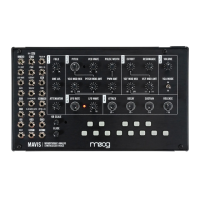Expanded Wave Folding | 9
Looking at our wave folding diagram, you’ll
notice that the square wave is already fully
“squared o” and distorted. Sending this
to a wave folder yields more subtle eects
than with saw or triangle waves, whose
linear shapes result in more “teeth.”
While there is no voltage control of Mavis’s
wave folder, you can use the LFO and
the ONE+TWO mixing section to achieve
something similar.
Typically, audio oscillators are centered
around zero volts. Therefore, since the ceiling
and floor thresholds are always symmetric,
the waves distort or fold symmetrically.
However, if we shift the entire wave up or
down, the wave folder will now distort the
top and bottom of the waves dierently.
MAKE THIS CONNECTION
Patch the LFO to input ONE (-5) of the
mixer and the VCO to input TWO of the
mixer. Finally, patch the ONE+TWO mixer
output to the FOLD IN input.
With this configuration, you can explore
wave folding even further —playing with
the VCO WAVE and LFO WAVE shapes, the
ONE LVL (which scales the LFO shifting
amount), and the FOLD knob.
By adding the LFO to the VCO, we are
actually shifting the VCO signal up and down
in time with the LFO. When the LFO rises
positively, the VCO signal is shifted in the
positive direction and hits the top mirror of
the wave folder, folding the positive peaks.
When the LFO falls negative, the VCO
signal is shifted in the negative direction
and hits the bottom mirror of the wave
folder, folding the negative troughs.

